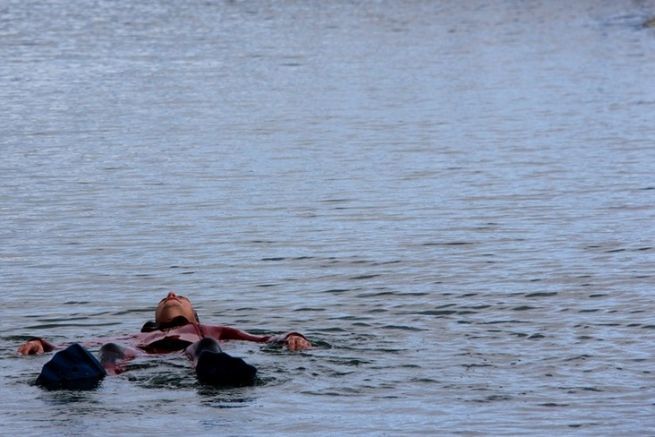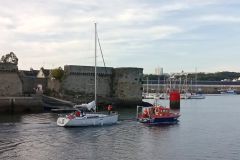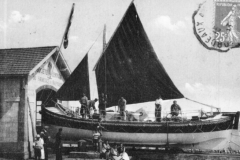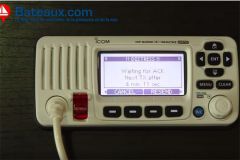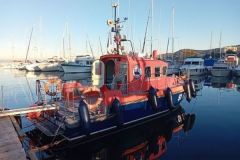It is in the very first moments after a person falls overboard that the chances of recovery are greatest. Often, reaching out or throwing a floating object attached to the boat - the famous horseshoe buoy - will be enough to save the fallen crew member. However, we must consider the case where this first attempt fails to prepare for the second.
Launching two floating devices
For this reason, a second floating device, free to move - therefore not attached to the boat - must be launched in the direction of the victim of this accident. Its main purpose will not be to allow him to get back on board, even if he can use it to float better. This second device will represent a visual cue allowing to locate the location of the team member's last view.
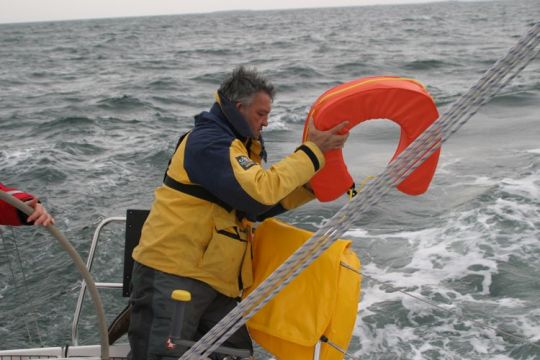
This place remains the " alpha point "The first thing to do is not to lose sight of this place. And the first thing to do is not to lose sight of this place. The team member who witnesses the accident has three things to do, in the following order:
- Fix the location of the fall
- Announcing the fall " A man in the sea! "
- Launching floating devices
In no case, whatever the reason, he must not take his eyes off the castaway. His gaze is really the lifeline that connects the victim, in the first sense of the word. Victims of a fall overboard tell us many times that they have caught the gaze of one of the people on board and have not let go of it during the whole operation.
This measure is vital for the latter. We insist, including assisting in the maneuver. The witness of the scene is responsible, from the moment he witnessed the accident, for the success of the recovery operation of the team member.
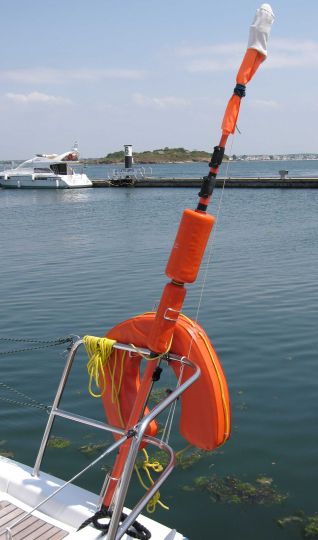
Finally, if you are equipped with one, we recommend that you place an IOR pole or other markers (floating cushions, etc.) in the water, which will make it easier to locate the landing point and optimize the recovery of the castaway.
Gathering information and raising the alarm
Once the fall has been announced, it is important that one of the team members notes the exact time and goes to press the " MOB "of the GPS and " DISTRESS " of the VHF.
All VHF DSCs meet the same alert principles :
- Lift the flap that covers the "DISTRESS" button
- Press the "DISTRESS" button
- On the display, select "MOB" or "Man overboard"
- Confirm the sending of the alert
Subsequently, this team member takes a piece of paper and writes down his or her first name, the time of day and the fact that he or she has triggered the alert. This document will be the foundation of the search document from which future searches will be triggered. If he has the information, he should add the location of the boat at the time of the alert, even if this vital information was sent at the same time as the VHF alert.
This first alert given electronically, it is important to confirm it in voice, on channel 16, by announcing a Mayday:
" Mayday Mayday Mayday
Here <Nom du Bateau> <Nom du Bateau> <Nom du Bateau>
A <Heure précise>person fell into the sea from my boat</Heure>.
I find myself <position géographique approximative>
My boat is a <type de bateau>sail/hull</type> <type de bateau> <couleur></type>
I request assistance
Completed "
Within a few moments, you should receive a message from the authorities - the CROSS if you are within VHF range - inviting you to collect ( repeat ) the message if it has not been well received or understood. If the message was clearly heard, the CROSS operator will invite you to join him on another channel:
" <Nom du Bateau> of CROSS
I suggest you switch to channel XX
Completed "
Then, before switching to this channel, you must confirm that you have understood the order given:
" CROSS of <Nom du Bateau>, I switch to channel XX</Nom>
Completed "
You must confirm the switch channel. It is possible that you misunderstood the channel number. In this case, another boat may have heard your answer and will join you on this erroneous channel to indicate your error or, as the case may be, will inform the CROSS on the correct channel of your error.
Depending on the location and language used, the operator may use certain terms that we recommend you have written down and printed next to the VHF:
- LKP: Last Known Position. This is the GPS position of the boat at the time of the accident
- Roger: This is the term used to indicate, in speech, that a message has been understood
- WX: Weather. This is the weather you see at the location where you are
- ETA: Estimated Time of Arrival. Estimated time of arrival of a means of transport
- PAX: Passengers. The number of passengers on board the boat
- Zulu: Zulu time is the time of the reference meridian, Greenwich. It is often called "GMT". It is useful to have a common time reference with the authorities.
It is important to follow this communication protocol, even though it may seem cumbersome and bombastic. It is the communication rule that will help organize rescue operations.
Killing certainties
The authorities are used to dealing with accidents of this type and have tools at their disposal for this purpose. It is important not to rely on any of your certainties, personal or collective. For example, you did not see the fallen person drifting with certainty (your boat was also moving). Similarly, you do not know what means (SNSM boat, helicopter, fishing boat ...) to deploy or request. Finally, it is the authority's operator who directs the maneuver and the communication and who asks you for information. He will know how to keep you informed if necessary and you must not have any secrets from him. For example, if he asks for a telephone number to reach you, do not think "confidentiality", but "safeguarding the life of your passenger" and communicate your telephone number.
One last tip, by the way, write down the phone number (satellite as well as GSM) where you can be reached next to the VHF, this will avoid wasting precious minutes looking for it.
Divide the tasks
The helmsman of the boat must, without delay, go towards the person who has fallen overboard. In order to do this, one of the maneuvers must be applied to return to the castaway.
It is at this moment that method, calm and rigor are imposed on the whole crew. There is only one priority left, to recover the man overboard. And there are only two actors left, the boat's pilot and the observer who has not yet left his post and who still has his eyes riveted on the fallen person. It is between these two people that communication must take place, the rest of the crew will be divided into two teams:
- The first one is in charge of eventually bringing the voice of the observer to the commander in simple terms ("To port", "ahead", "To starboard" ...) and without interpretation or addition of what they see themselves
- A second team member prepares to recover the fallen person by setting up the recovery equipment. It is obvious, these team members will have their vests on and will be attached to the life line to avoid an accident.
Reduce outgoing communications from the ship to a bare minimum
If the castaway has not been lost from sight, it will be easier to return to him and recover him. The action and movement must be carried out with clarity and firmness while knowing what to do. The skipper of the vessel can limit the messages to the CROSS to what is strictly necessary, informing that he is starting the recovery maneuver and, if necessary, requesting assistance from other vessels in the area. The operator will know that the boat is in action and will relay the request to the other vessels present, based on the strength of the location initially provided. You understand, therefore, the importance of the first messages transmitted, which will then free you to do things.
NB:
This is absolutely not the right time to inform anyone on land of this incident. Not only could you unnecessarily worry the victim's entourage, but, in addition, this anxious entourage will be an additional burden for the skipper to manage. The pressure of these people at a distance is far too much to handle in addition to the pressure of the operation in progress.
Be quiet, don't smoke and listen
The reason our vests are equipped with a whistle is so that we don't have to scream if we fall. To hear the sound of the whistle, it is important not to speak or make any noise. Only the motorization of the boat, if any, and the communications between the observer and the pilot should intervene.
Prepare and allocate responsibilities
It is inconceivable to define everyone's roles and responsibilities at the time of the accident. Stress will make everyone try to do the right thing at the risk of making the whole action fail. It is through preparation exercises as soon as possible, on the one hand, and through a distribution of roles on the other hand, that things can succeed and take place with a minimum of stress. This distribution must be thought out " in any case "That is, even if the person in charge goes overboard.
Keep in mind that this maneuver will be stressful and anxious, for the crew of course, but even more so for the person who fell overboard. Arguments, screaming and other excesses have no place in the operation and should be avoided as much as possible, keeping in mind that there is only one priority at this precise moment, saving the life of the fallen friend.
And do it as quickly as possible!
